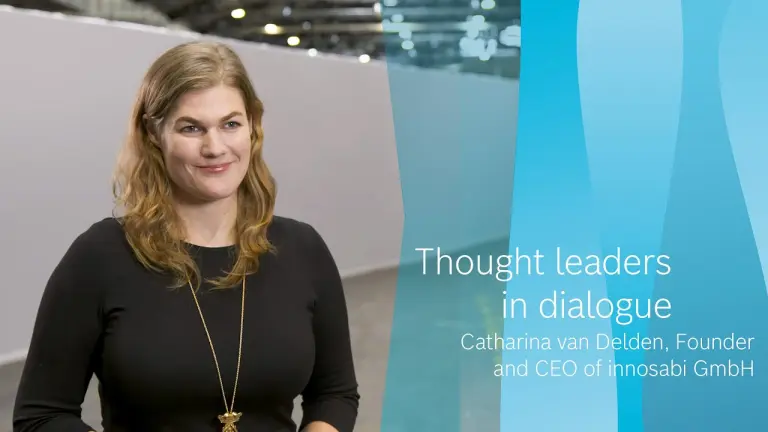Agile innovation management — the art of invention
In dialogue with the CEO of innosabi

2020-06-22
Catharina van Delden helps companies to become more innovative. To do this, the software company founder demands a special corporate culture: diversity — and names four key principles.

“I’m a curious person,” says Catharina van Delden, “and I’m always interested in new ideas, cultures, and friendships.” Those traits are undoubtedly the core competencies she needs in her job as CEO of innosabi GmbH, one of the leading providers of innovation management software. That’s because she wants to pass on the urge to discover the unknown to her customers as well. “For companies that want to stay ahead in the digital game, they really need to enforce their innovation activities. Digital business is all about innovativeness. It is all about who delivers the most customer value in the end by creating new products and services,” explains van Delden.
“Innovation is proof that the future exists, that there is progress and that things get better.”
Innovation in four simple principles
But are innovative products and services really that easy to predict? “Innovation is a creative process that is very natural to us humans,” says van Delden. That’s why she insists that companies leverage this potential — it’s the only way they can react to the challenges posed by the digital world such as shorter product cycles. An agile innovation management is needed to maintain this increased tempo. van Delden’s approach is founded on four principles:
Openness
Innovation management benefits strongly from a direct and transparent discussion between all of the relevant stakeholders. This requires an open corporate culture.
Prototypes
Innovation management accompanies an idea until it is implemented. The target group is involved in a product’s creation process. This means product versions can be tested and improved at an earlier stage.
Cooperation
Innovation management should involve extensive cooperation — especially with customers. It’s easy — and likely to lead to success — to ask customers precisely what it is that they want.
Adaptability
The innovation process needs to be flexible from start to finish. Agile innovation management is all about reacting to changing external requirements and being able to adapt at any time.
AI and innovation management
Software programs developed by innosabi are designed to help in the implementation of innovation processes. They provide a platform that can network all of the stakeholders, allowing knowledge, data, and inspiration to be exchanged directly. As is the case in so many business sectors, artificial intelligence can also be a driver here: “In order to find the relevant data and to connect the right people, artificial intelligence becomes very valuable,” says van Delden. As part of this, she focuses on using machine learning to train AI so that the right people can be put in touch with each other even faster based on the existing expertise at the company.
Although van Delden strongly believes that “the associates are always the focus of the innovation process,” this process should be guided by innovation management software. “Our customers are increasing the speed in their innovation processes. That is true for all phases. Finding the relevant technology faster, answers for prototype testing faster, from finding the needs of the market to implementing the product in the market.” Using AI to accelerate the development process like this ensures that you have a competitive edge and therefore commercial success.
Make mistakes, create innovations
van Delden also says that the company’s corporate culture must play an active role in making agile innovation management — and she doesn’t just mean providing free food or a foosball table in the recreation room. She puts a lot more stock into the questions of: “How do we bring our top performance and are we allowed to make mistakes? That’s what drives innovativeness.” A corporate culture that forgives mistakes gives associates the courage to think outside the box and cross boundaries — “and therefore learn and experience new things and build new business models and products.”

“It is always worth trying the new.”
Diversity as a model for success
van Delden considers diversity to be another key to developing innovation: “We have to appreciate and value the individuality of a human being. Truly everybody can have a good idea. It should be taken seriously and into collaboration to develop a new product and service.” For her, an ideal team consists of associates from different backgrounds that bring different experiences and knowledge to the table. Pooling all of those “sparks of genius” together on one platform might light the way to new innovations.
An interview with Catharina van Delden, Founder and CEO of innosabi GmbH

Loading the video requires your consent. If you agree by clicking on the Play icon, the video will load and data will be transmitted to Google as well as information will be accessed and stored by Google on your device. Google may be able to link these data or information with existing data.
Profile

Catharina van Delden, 35
Founder and CEO of innosabi GmbH
Innovation is the legitimate reason to believe that things will get better.
Catharina van Delden did her MBA at TU München (the Technical University of Munich) and UC Berkeley after completing her bachelor’s in Business Administration and Life & Food Sciences. She is the author of the book “Crowdsourced Innovation — Revolutionizing Open Innovation with Crowdsourcing.” van Delden has been on Bitkom’s steering committee since 2013, in 2014 she was honored as a “thought leader of the digital age” by the Gesellschaft für Informatik (German Informatics Society) as part of its “digitale Köpfe” (digital minds) initiative, and since 2017 she has been on the South Advisory Board for Deutsche Bank AG. Along with three fellow students, she founded the startup company innosabi straight after she graduated from TU München in 2010 and she is still the CEO today.
Summary
Catharina van Delden calls on companies to embrace agile innovation management. She establishes this on elements including a concrete error culture, diversity in the teams, and the use of software and AI.


